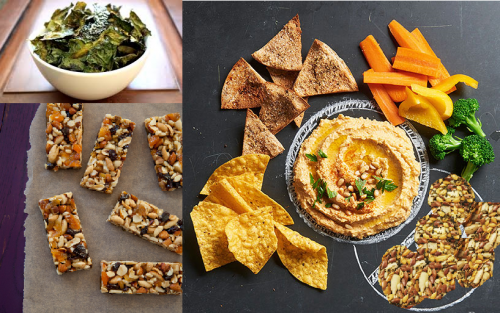Healthy Nurse, Healthy Nation™ Blog - 10 Healthy At-Home Convenience Foods
Skip the store and whip up these foods in your own kitchen for tastier, healthier, and cheaper fare.
 When you’re juggling a demanding nursing job, family responsibilities, and trying to be healthy, store-bought convenience foods may seem like the only option. But even relatively healthy supermarket finds are often loaded with preservatives, sodium, and calories. The good news: Making these foods at home can be a snap. When you do, they will usually boast more nutrition and better taste. They may even be more affordable, too.
When you’re juggling a demanding nursing job, family responsibilities, and trying to be healthy, store-bought convenience foods may seem like the only option. But even relatively healthy supermarket finds are often loaded with preservatives, sodium, and calories. The good news: Making these foods at home can be a snap. When you do, they will usually boast more nutrition and better taste. They may even be more affordable, too.Try whipping up these ten snacks at home (you may never go back to the packaged variety):
1. Granola
A typical half cup serving of store-bought granola has upwards of 10 grams of sugar, plus sodium and possibly high fructose corn syrup. Homemade granolas, on the other hand, can include the healthy ingredients you love – nuts, seeds, and even dark chocolate – but without the unhealthy extras. Mix your base ingredients with a little bit of sweetener (think raw honey or Grade B maple syrup) and a healthy fat, like coconut oil. Then, spread on a cookie sheet and bake until toasted. Want to give it a try? Here’s a recipe for Healthy, Homemade Granola.
2. Hummus
Although hummus is a solid snack choice, preparing it yourself can make it even healthier. The popular Middle Eastern dip found on store shelves tends to be high in unnecessary salt as well as chemicals that help make it last longer on the shelf and in your fridge. To skip the preservatives and added salt, mix chickpeas, tahini, lemon juice, and olive oil in a blender at home. For extra flavor, add your favorite spices, crushed garlic, or cracked red pepper. Try this Traditional Hummus recipe.
3. Crackers
Many crackers found in the grocery store aisle appear to be healthy choices, but they’re often high in sugar, sodium, unhealthy fats, and artificial flavors. When you make your own at home, you can control what goes in them (this recipe uses raisins, sunflower seeds, and sprigs of rosemary). Making crackers might seem complicated, but the process is actually pretty easy. Just blend the ingredients in a food processer, flatten the dough, cut into squares, and bake for 15 minutes. Store in an ait-tight container and they can last for up to 3 to 4 weeks.
4. Guacamole
Ever wondered why guacamole made table-side at Mexican restaurants tastes better than the packaged kind? Because the restaurant variety uses fresh ingredients including real avocado. Meanwhile, guacamole spreads you find at the store tend to have sour cream as one of the first ingredients. Many companies use sour cream as a filler so they can use less avocados (the delectable fruit is pricey). The sour cream not only replaces heart-healthy fat with the saturated variety, it also adds empty calories. A better bet: Make guacamole at home with less than five ingredients: avocado, lime juice, salt, garlic, and cilantro. You can also add onions, tomato, or a hot pepper for spice. Mash with a potato masher and serve with homemade tortilla chips (recipe below) or with cut-up veggies. Here’s a step-by-step guacamole making tutorial.
5. Tortilla Chips
The chips you find on grocery store shelves tend to be deep-fried and full of fat, calories, and salt. But you can make your own using basic corn tortillas. Cut them into triangles, brush with your favorite oil, and sprinkle with salt. When you make them, you can control how much salt and oil to use. Try this Homemade Tortilla Chips recipe.
6. Ricotta Cheese
If you look at the label on the ricotta cheese you get in a plastic tub at the dairy section, you’ll find it’s filled with stabilizers like xantham and guar gum. While making ricotta at home requires two ingredinets and just three steps. Heat milk in the microwave, add vinegar, and then drain it. Here are step-by-step instructions.
7. Salad Dressing
Your favorite low-fat salad dressings likely have shelf-stabilizing chemicals, plus way more salt and sugar that you’d want on your salad. Making your own vinaigrette by mixing olive oil, vinegar, and any spices you like. Try basic dressings to more advanced ones (think Caesar or Green Goddess) with these 15 Healthy Salad Dressing Recipes.
8. Croutons
Not only are homemade croutons healthier, but they also give you an opportunity to use stale bread and waste less. Toast whole wheat bread, healthy oil, and spices to add crunch to soups and salads, minus the hard-to-pronounce ingredients. Try these Whole Wheat Croutons.
9. Pesto Sauce
Traditional pesto only requires blending five ingredients: basil, olive oil, parmesan cheese, garlic, and nuts. However, supermarket varieties often use unhealthy oils and include preservatives. Try this simple recipe for Basic Basil Pesto to add to pasta, shrimp, or to spread on a sandwich.
10. Pudding
Both powdered pudding mix or premade pudding cups include thickening agents like carrageenan, as well as hydrogenated oils, and artificial dyes. But when you make pudding at home, you can use whole ingredients to add flavor (like dark chocolate pieces, cocoa, or vanilla beans). Try these recipes for chocolate pudding, vanilla pudding, or even this delicious avocado breakfast pudding.
Every step you take to be healthier is a good one. If the idea of making any of these recipes at home feels overwhelming to you, don’t stress. You can always find healthier alternatives at the grocery store by scouring ingredient lists. But if you want to revamp one of your staples to make them healthier, go for it! Even if you don’t conquer all of these at once, hopefully you have some ideas for future.
Will you make one of these? Let us know how it goes by posting in our private Facebook group or in our discussion. Or tell us about the foods you like to make yourself! Feel free to share this post on social media by clicking the icons to the left.
Find this helpful? Consider sharing it with a friend by clicking on the social media icons on the left side of this page. Don't forget to tag us with #HealthyNurse. Find us on Facebook, Twitter, or Instagram.
Source:
USDA Nutrient Data Laboratory. (n.d.). Retrieved February 9, 2018.
Links reviewed and updated 12/14/22



Post a Comment or Question